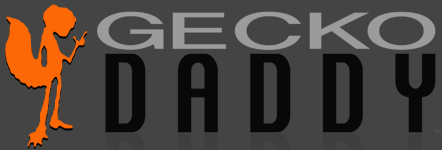Leopard Gecko Genetics—Part 1
Have you ever felt like you needed to be a geneticist in order to figure out the difference between one leopard gecko morph and another? Have you ever wondered why one leopard gecko may cost three times as much as another when they look virtually the same? Do you have great plans to create a new leopard gecko morph that has never been seen before?
Leopard gecko breeding often requires a basic, and in some cases advanced, understanding of genetics. Good thing we all paid attention in our biology classes, right? When we understand genetics, we not only understand why a gecko may look the way it does, but we can also predict what it will look like before it even hatches. Here are some of the basic genetic terms and concepts that we needed to be reminded of:
Trait: A genetically determined characteristic or condition. Traits are the results of the genetic code that is provided by the parents—the genes.
Gene: Genes contain information about a specific trait. Genes are made up of one or more pairs of alleles. Each parent provides one of the alleles to the genetic code that determines the trait.
Allele: A gene that codes for a certain characteristic. Some alleles are dominant and some alleles are recessive. Dominant alleles are usually represented by uppercase letters while recessive alleles are represented by lowercase letters.
Genotype: The alleles of a certain characteristic.
Homozygous: When the genotype consists of two of the same alleles
Heterozygous: When the genotype consists of two different alleles, one being the dominant allele and the other being a recessive allele. This state is often referred to as being het for a trait.
Dominant: Dominant alleles are expressed even when only one allele is present.
Recessive: Recessive alleles are only expressed when paired with another recessive allele.


(The above geckos are both patternless super snows, but one is a Las Vegas albino and the other is 66% het for Las Vegas Albino.)
Let’s take an example of an albino leopard gecko and walk through the outcome of pairing an albino leopard gecko with a normal leopard gecko. In order to determine what you will get when you cross an albino leopard gecko with a normal leopard gecko, it helps to create a Punnett square. A Punnett square is a diagram that is used to predict the outcome of combining various paternal and maternal alleles.
The albino trait is made up of recessive alleles, which means that the trait is only expressed in the homozygous state. In our Punnett square we will designate the albino trait as (aa), each allele for the albino trait being represented by an “a”. The normal trait is the dominant trait. We’ll say its genotype is (AA), each allele represented by an “A”.
So this is what we begin with as we create our Punnett square:
The above Punnett square has the recessive alleles for the albino trait listed in the top row and the dominant alleles of the normal trait listed down the left column. As we fill in our chart this is what we get:
Each of the offspring of this pairing will be heterozygous (het) for the albino trait because the recessive albino allele is present in each of the offspring, but you will not be able to see the trait expressed because it is recessive. If the albino trait were a dominant trait, it would be visible in every offspring.
Being het for a trait may increase the value of an animal, even if the gecko looks normal. In the above example, since the albino gene is recessive, you can't see it, but you may be charged a higher price for it.
When pairing two heterozygous albino leopard geckos together the outcome is varied. Here is what that looks like:

When pairing hets, the odds are that 25% of the offspring will express the recessive trait, while the other 75% will not. The tricky thing here is that 66% of those that do not express the trait will be het for that trait, only you will not know which ones are het and which ones are not. This is why some animals are identified as 66% het, like the patternless super snow het Las Vegas albino above.
It's important to remember that the Punnett square gives the odds, but it does not mean that one out of four is guaranteed to be albino. The odds are that this will be the case if you hatch, say, 100 geckos.
A het paired with an albino gives you 50% homozygous for the albino trait and 50% heterozygous (het) for the albino trait. The easy rule is that if one of the paired animals is homozygous for the recessive trait (an albino gecko for example), then all of the offspring are guaranteed to either express the trait or be het for the trait.
Obviously albino to albino is easy. Even though the trait is recessive, the outcome is a guaranteed that 100 % will be albino. Here it is:
You can find some online interactive Punnett squares that allow you to fill in genetic information and they will help you figure out what your odds are as you mix different leopard gecko traits. Here is a good one: Advanced Genetics Wizard
As you get into leopard gecko genetics things can get complicated, but really fun, especially when you hatch out a morph that beats the odds and has a combination of recessive traits that are expressed at the same time. It definitely makes this hobby exciting and who knows, you may be the first to hatch out a new morph that no one has ever seen before!




